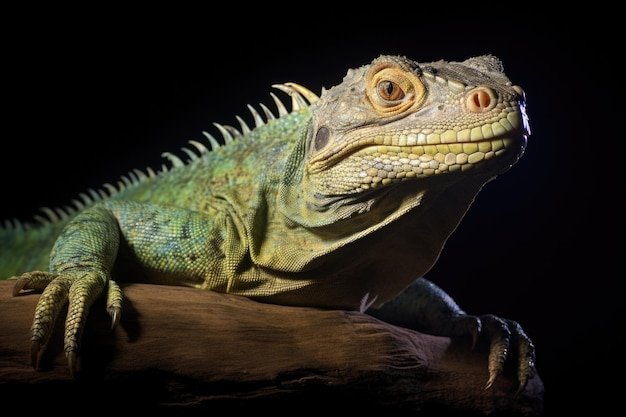
So, how do you set this up? If you’re new to the reptile game, the idea of UVB lighting and heating needs might feel overwhelming. But don’t sweat it; it’s all about understanding what your iguana needs to mimic its natural habitat. Let’s take a deep dive into the essentials of UVB lighting and heating for iguanas.
Understanding the Role of UVB Lighting
You might be wondering, what’s the big deal about UVB lighting anyway? Well, just like humans need sunlight for vitamin D, iguanas rely heavily on UVB rays to produce this crucial vitamin for calcium absorption. Without adequate UVB exposure, iguanas can suffer from metabolic bone disease, which is pretty much like their bones turning to jelly. Ouch!
Here’s the thing: UVB lighting mimics the sun’s rays. It helps iguanas metabolize calcium, which is vital for their bone health and overall development. The right amount of UVB can help your iguana thrive, ensuring it has strong bones and a vibrant attitude. You’ll often see bulbs labeled as “full-spectrum” or “UVB” in pet stores—these are what you’ll be looking for!
Types of UVB Lighting
Now, not all UVB bulbs are created equal. You have a couple of options to choose from:
- Fluorescent Bulbs: These are popular and cost-effective. They provide a wide span of UVB rays and are usually easy to install.
- Mercury Vapor Bulbs: These are like the heavyweights of UVB lighting. They emit both UVB and heat, making them a great two-in-one solution.
Each type has its benefits. Fluorescent bulbs are ideal for smaller setups or if you’re just starting out, while mercury vapor bulbs can create a more natural climate if you have a larger habitat. Just remember, placement is key—these lights should be positioned correctly to ensure your iguana gets the full benefit.
Heating Needs for Iguanas
Let’s shift gears and talk about heat. Just like you’d want to be warm and toasty on a chilly day, iguanas need heat to regulate their body temperature. They’re ectothermic, meaning their bodies rely on external sources to get warm. In the wild, they bask in the sun to soak up warmth. In your home, you need to replicate this basking spot.
To create a comfortable environment, aim for a temperature gradient in your tank. This means having a warm side and a cooler side. The warm side should be around 85–95°F (29–35°C) for basking, while the cooler side can sit around 70–75°F (21–24°C).
Heating Options
So, how do you provide heat? Here are a few options:
- Heat Lamps: These give off directed heat and simulate the sun’s warmth. You can position them above the basking area.
- Under Tank Heaters: A heating pad placed under part of the tank can help provide consistent warmth without taking up space.
Heating lamps are great because they can mimic natural sunlight, while under tank heaters provide a steady warmth that can just be comforting. Just keep an eye on the temperatures with a thermometer, so you don’t accidentally turn your iguana’s home into a sauna!
Combining UVB and Heating for Optimal Health
Now that you know about UVB lighting and heating separately, let’s talk about how they work together. Imagine this: you’ve got your iguana basking under a warm light basking, soaking up both heat and UVB rays. That’s the sweet spot!
To set this up, place your UVB bulb within 12–18 inches from where your iguana will be basking. Make sure your heat lamp is also positioned correctly—somewhere that allows your iguana to move back and forth between warm and cooler areas. Providing an environment where your iguana can choose its preferred temperature is key to keeping it happy and healthy.
Common Mistakes to Avoid
Here are a few common pitfalls to steer clear of when setting up your iguana’s habitat:
- Too Much Distance: If the UVB bulb is too far away, it won’t have the desired effect. Get that light close enough!
- Inconsistent Temperatures: Make sure your heat sources are reliable. You don’t want your iguana to be too cold or too hot.
Avoiding these mistakes will help maintain a balanced environment, keeping your iguana active and vibrant.
Monitoring Your Iguana’s Environment
Keeping an eye on the temperature and UVB output is essential. Thankfully, there are tools to help you do just that! Using a digital thermometer and a UV meter can give you peace of mind.
Check the temperatures daily, especially if your home’s climate changes. Also, keep an eye on your iguana’s behavior. If it’s spending too much time in the shade or looking lethargic, it could be a sign that adjustments are needed.
Adjusting as Needed
As your iguana grows, its needs may change. You’ll need to update its habitat and possibly the type of UVB lighting or heating you’re using. This is especially true if you’re using a UVB bulb that has a limited lifespan, usually around 6–12 months.
Also, don’t forget to change bulbs regularly. The effectiveness of UVB bulbs decreases over time, so keeping up with maintenance ensures your iguana gets the best care possible.
Choosing the Right Products
When it comes to selecting the right products for UVB lighting and heating, quality matters. It might be tempting to go for cheaper options, but remember that you’re investing in your pet’s health.
Look for reputable brands that cater specifically to reptiles. Products like Zoo Med and Exo Terra often come highly recommended. They typically offer a variety of UVB bulbs and heat sources tailored to your iguana’s needs.
Considerations for Different Iguana Species
Not all iguanas are created equal, and different species might have slightly different needs. For example, a Green Iguana might require a more intense lighting setup compared to a smaller species like the smaller Fijian Iguana.
Research is key! Make sure to look into the specific requirements of the iguana species you have or are thinking of getting. Each one can have unique requirements for lighting and heating based on their natural habitat.
Setting up the right UVB lighting and heating for your iguana doesn’t have to be intimidating. With a bit of understanding and the right tools, you can create a cozy and healthy environment that mimics their natural habitat.
Remember, your goal is to recreate the warmth of the sun with proper heating and give your iguana the essential UVB rays it needs for overall health. Take some time to observe your iguana’s behavior and adjust the setup accordingly. By following these guidelines, you’ll be well on your way to raising a lively and happy iguana!

